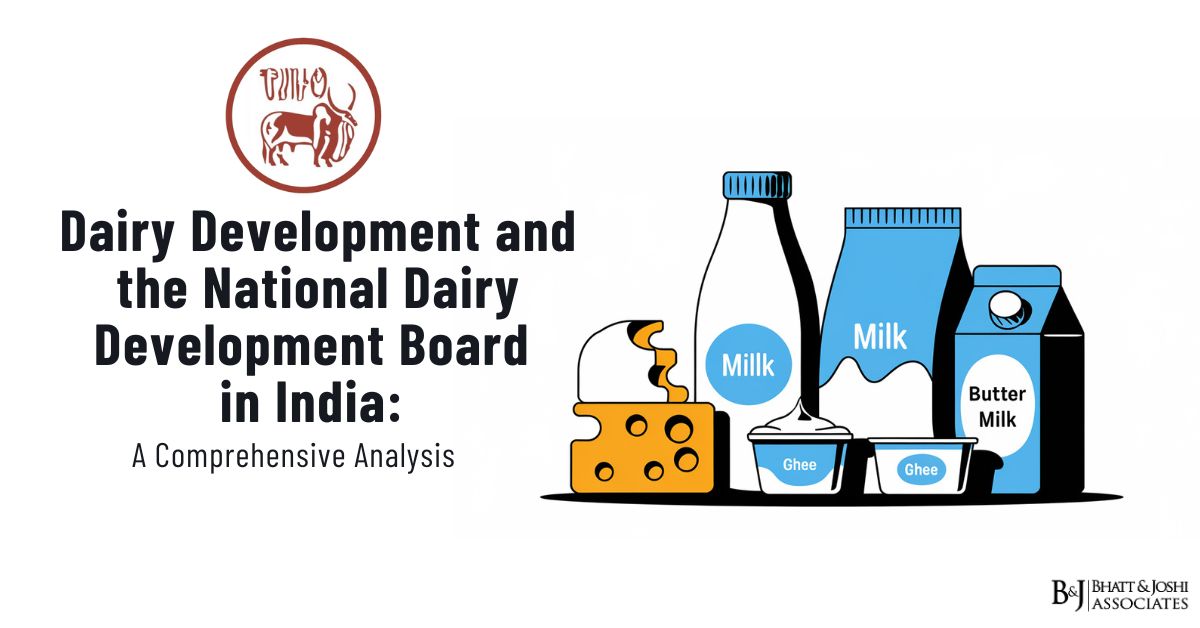Introduction
The dairy sector in India holds a unique position in the country’s agricultural landscape, playing a crucial role in rural development, nutrition, and economic growth. India’s journey from a milk-deficient nation to the world’s largest milk producer is a testament to the success of its dairy development initiatives. At the heart of this transformation lies the National Dairy Development Board (NDDB), an institution that has been instrumental in shaping India’s dairy industry. This article delves into the multifaceted aspects of dairy development in India, exploring the historical evolution of the sector, the establishment and role of the NDDB, and the regulatory framework that governs this vital industry.
Evolution of India’s Dairy Sector: From Independence to the White Revolution
The story of India’s dairy development is intrinsically linked to the country’s struggle for food security and rural empowerment. In the pre-independence era, milk production in India was largely unorganized, with small, scattered producers catering to local needs. The partition of India in 1947 further strained the dairy sector, as many important milk-producing areas became part of Pakistan.
The post-independence period saw initial attempts to organize the dairy sector, with the government establishing milk schemes in major cities. However, these efforts were limited in scope and impact. The true turning point came in 1965 with the launch of Operation Flood, often referred to as the “White Revolution.” This program, initiated by Dr. Verghese Kurien, aimed to replicate the success of the Kaira District Co-operative Milk Producers’ Union (Amul) across the country.
Operation Flood was not just a milk production program; it was a comprehensive rural development initiative that sought to create a “flood” of milk by connecting rural milk producers with urban consumers. The program was implemented in three phases from 1970 to 1996 and laid the foundation for India’s modern dairy industry.
The National Dairy Development Board: Establishment and Mandate
The National Dairy Development Board (NDDB) was established in 1965 by an Act of Parliament. The NDDB Act, 1987, which replaced the original 1965 Act, provides the current legal framework for the Board. The preamble of the Act clearly states its purpose:
“An Act to establish a National Dairy Development Board for the purpose of promoting dairy development in the country in a scientific and efficient manner and for matters connected therewith and incidental thereto.”
This statement encapsulates the broad mandate given to the NDDB in fostering the growth and modernization of India’s dairy sector.
The objectives of the NDDB, as outlined in Section 16 of the Act, include:
Promoting and accelerating dairy development activities through cooperative strategies. Providing technical and management support to dairy cooperatives. Facilitating research and development in the dairy sector. Implementing training programs for dairy professionals and farmers. Assisting in the formulation of national policies related to dairy development.
These objectives underscore the comprehensive role envisioned for the NDDB in nurturing and modernizing the dairy sector.
The NDDB’s approach to dairy development is rooted in the cooperative model, which aims to empower small and marginal farmers by providing them with access to markets, technology, and support services. This model, often referred to as the “Anand Pattern” after the successful Amul cooperative in Anand, Gujarat, has been replicated across the country with significant success.
Regulatory Framework Governing Dairy Sector in India
The regulatory framework governing the dairy sector in India is multifaceted, involving various laws, rules, and regulations. While the NDDB plays a crucial role in policy formulation and implementation, several other regulatory mechanisms are in place to ensure the quality and safety of dairy products.
The Food Safety and Standards Act, 2006
This Act provides the overarching legal framework for food safety in India, including dairy products. It establishes the Food Safety and Standards Authority of India (FSSAI) as the apex body for regulating the food sector. Key provisions related to the dairy industry include:
Setting standards for milk and milk products. Licensing and registration of dairy businesses. Enforcement of food safety measures in the production, processing, and distribution of dairy products.
Section 16(1) of the Act states:
“Notwithstanding anything contained in any other law for the time being in force, the Food Authority shall have the duty to regulate and monitor the manufacture, processing, distribution, sale and import of food so as to ensure safe and wholesome food.”
This provision underscores the comprehensive regulatory approach to ensuring food safety, including in the dairy sector.
The Milk and Milk Product Order, 1992
This Order, issued under the Essential Commodities Act, 1955, regulates the production, supply, and distribution of milk and milk products. Key provisions include:
Registration of dairy plants. Quality standards for milk and milk products. Measures to prevent adulteration of milk.
The Order defines “milk product” in Section 2(c) as:
“a product obtained by processing milk, which contains milk and milk constituents as essential ingredients in such quantities as specified under the Prevention of Food Adulteration Rules, 1955.”
This definition helps in clearly delineating the scope of products covered under the regulatory framework.
key Case Laws Shaping Dairy Sector
The dairy sector has been subject to various legal disputes and interpretations over the years, reflecting the complex interplay of stakeholder interests and regulatory objectives. Some significant case laws include:
Gujarat Cooperative Milk Marketing Federation Ltd. & Anr. vs. Amul Sales Products & Ors. (2006)
In this case, the Supreme Court of India dealt with the issue of trademark protection for dairy products. The court observed:
“The ‘Amul’ trademark, having acquired a distinctive character and reputation, deserves protection not just against identical marks but also against deceptively similar marks that may cause confusion in the minds of consumers.”
This judgment underscored the importance of brand protection in the dairy industry and set a precedent for trademark disputes in the sector.
Nestle India Limited vs. Food Safety and Standards Authority of India (2015)
This high-profile case involved the ban on Nestle’s Maggi noodles due to alleged presence of excess lead and mislabeling regarding MSG content. While not directly related to dairy products, this case had significant implications for food safety regulations in India. The Bombay High Court, while setting aside the ban, emphasized:
“Food safety is of paramount importance, but regulatory actions must be based on credible scientific evidence and follow due process of law.”
This judgment highlighted the need for a balanced approach to food safety regulations, which is equally applicable to the dairy sector.
The Role of NDDB in Dairy Development
The National Dairy Development Board has played a pivotal role in transforming India’s dairy sector. Its activities span several crucial areas:
- Cooperative Development: The NDDB has been instrumental in promoting and strengthening dairy cooperatives across the country. These cooperatives have empowered millions of small and marginal farmers by providing them with access to markets, fair prices, and support services.
- Technical Support: The Board provides technical assistance to dairy cooperatives and farmers in areas such as animal breeding, nutrition, and health. This has contributed to significant improvements in milk yields and animal productivity.
- Market Development: Through initiatives like the creation of the Mother Dairy brand, the NDDB has helped in developing organized markets for milk and milk products. This has ensured stable demand and fair prices for milk producers.
- Research and Development: The NDDB supports research in various aspects of dairying, including animal genetics, feed and fodder development, and milk processing technologies. The National Dairy Research Institute (NDRI) works closely with the NDDB in these efforts.
- Training and Capacity Building: The Board conducts extensive training programs for dairy professionals, cooperative leaders, and farmers. The NDDB Dairy Services, a subsidiary of NDDB, plays a key role in these capacity-building efforts.
- Policy Advocacy: The NDDB advises the government on dairy-related policies and represents the interests of the dairy sector in policy formulation.
These multifaceted interventions by the NDDB have been crucial in shaping the development trajectory of India’s dairy sector, enhancing its productivity, and addressing various challenges faced by dairy farmers.
Recent Developments and Initiatives
In recent years, the dairy sector has witnessed several significant developments, many of which have been supported or facilitated by the NDDB:
- National Dairy Plan: Launched in 2012, this World Bank-supported program aims to improve milk production and provide greater access to the organized milk processing sector. The plan focuses on enhancing productivity through scientific breeding and nutrition.
- E-commerce Initiatives: The NDDB has supported cooperatives in adopting e-commerce platforms for direct marketing of dairy products to consumers, a trend that has accelerated during the COVID-19 pandemic.
- Focus on Value-Added Products: There has been an increasing emphasis on diversifying into value-added dairy products like cheese, yogurt, and probiotic drinks. This helps in improving the profitability of the dairy sector and meeting changing consumer preferences.
- Emphasis on Quality and Food Safety: The NDDB has been working closely with the FSSAI to implement stringent quality control measures across the dairy value chain.
- Promotion of Clean Milk Production: Initiatives to improve hygiene and quality in milk production at the farm level have been a key focus area.
Challenges and Future Prospects of Dairy Sector
Despite its remarkable growth, the dairy sector in India faces several challenges:
- Low Productivity: Despite being the world’s largest milk producer, India’s per-animal milk yield remains low compared to global standards.
- Quality Control: Ensuring consistent quality across the vast and diverse dairy sector remains a challenge.
- Climate Change: Changing climate patterns affect fodder availability and animal health, posing risks to milk production.
- Competition: The entry of private players and multinational companies has intensified competition in the dairy sector.
The NDDB and related policy initiatives are addressing these challenges through various measures:
- Genetic Improvement Programs: Focusing on breed improvement to enhance milk yields.
- Fodder Development: Promoting scientific fodder cultivation and conservation practices.
- Technology Adoption: Encouraging the use of technology in milk collection, processing, and quality testing.
- Sustainable Dairying Practices: Promoting environmentally sustainable practices in dairy farming.
Conclusion
The dairy sector in India, with its rich history and significant economic and nutritional impact, continues to evolve under the guidance of the National Dairy Development Board and related regulatory mechanisms. The sector’s journey from a subsistence activity to a professional, market-oriented industry reflects the broader transformation of India’s rural economy.
The NDDB, through its multifaceted interventions, has played a crucial role in this transformation, empowering millions of small and marginal farmers and ensuring food security for the nation. As the industry moves forward, the NDDB’s role in facilitating adaptation to new challenges and opportunities will be critical.
The future of the dairy sector in India is closely tied to broader issues of rural development, nutritional security, and environmental sustainability. The industry’s ability to balance these diverse objectives while maintaining economic viability will be key to its long-term success.
As global and domestic markets evolve, the Indian dairy sector, supported by the NDDB and adaptive policy measures, is poised to play a significant role not just in meeting the nutritional needs of the population but also in driving rural economic growth and empowerment. The challenges are significant, but so are the opportunities for innovation, sustainability, and inclusive growth in this vital sector of the Indian economy.














